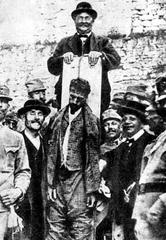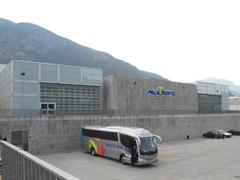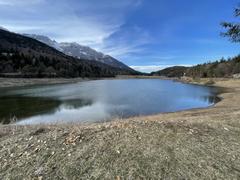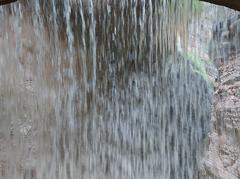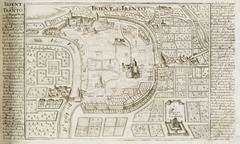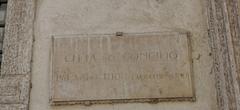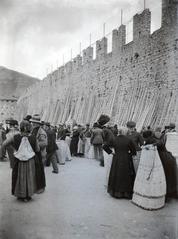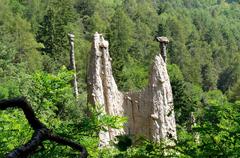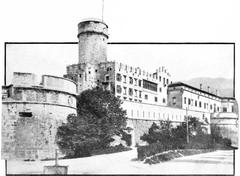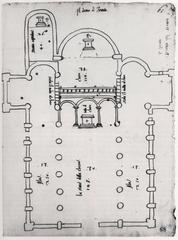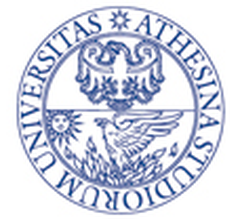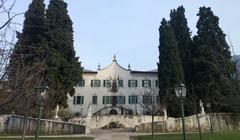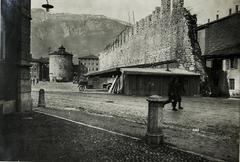Antonio Gazzoletti Monument Trento: Visiting Hours, Tickets, and Travel Guide
Date: 14/06/2025
Introduction: History and Significance of the Antonio Gazzoletti Monument
Situated in the heart of Trento, Italy, the Monument to Antonio Gazzoletti is a powerful homage to one of the region’s most influential figures of the 19th century. Antonio Gazzoletti (1813–1866), a revered poet, lawyer, patriot, and activist, was instrumental in the Italian Risorgimento—the movement for Italy’s unification—and championed the affirmation of Trentino’s Italian cultural identity during Austro-Hungarian rule. Erected in Piazza Dante, adjacent to Trento’s main railway station, the monument is a focal point for visitors engaging with the city’s historical and cultural legacy.
Inaugurated in 1913, marking the centenary of Gazzoletti’s birth, the monument is both a work of art and a symbol of ideals such as patriotism, literary achievement, and humanitarianism—values that defined Gazzoletti’s life and continue to resonate in Trento’s civic consciousness. The monument’s location amidst a 19th-century park, near architectural landmarks like the rationalist railway station by Angiolo Mazzoni and the modernist Palazzo della Regione, makes it an accessible and enriching destination for those exploring Trento’s layered history.
This guide delves into the monument’s origins, symbolism, architectural features, and offers practical visitor information, including opening hours, accessibility, and helpful tips. It also highlights nearby attractions such as Buonconsiglio Castle and Trento Cathedral, and points out cultural events held in Piazza Dante, enabling a comprehensive and engaging exploration of Trento’s heritage. For the latest updates and expanded resources, consult the official Trento tourism office (Trento.info) and regional guides (Regione Trentino-Alto Adige).
Table of Contents
- Introduction
- Historical Background
- Architectural Features
- Symbolism and Artistic Interpretation
- Significance in Trento’s Cultural Landscape
- Practical Visitor Information
- Cultural Events at Piazza Dante
- Nearby Attractions
- Recommendations for a Memorable Visit
- FAQ
- Visitor Services and Resources
- Visual and Interactive Recommendations
- Language and Communication
- Conclusion
- References
Historical Background
Antonio Gazzoletti (1813–1866) was a leading figure in the Italian Risorgimento, renowned for his poetry, legal work, and patriotic activism. Born in Nago, Trentino, he became a symbol of the region’s Italian identity, advocating for unification at a time when Trentino was under Austrian rule. His contributions to both literature and national consciousness are celebrated through this monument, commissioned by local authorities and cultural societies to honor his centenary (Wikidata).
Architectural Features of the Monument
The Monument to Antonio Gazzoletti is a classic example of early 20th-century commemorative sculpture. Crafted from durable local stone and bronze, it features:
- Central Bronze Bust: Gazzoletti is depicted in a contemplative, statesman-like pose, symbolizing intellectual and civic virtue.
- Pedestal or Plinth: Made from local stone, inscribed with his name, lifespan (1813–1866), and dedications reflecting his achievements.
- Decorative Reliefs and Motifs: Allegorical elements such as laurel wreaths (for poetry) or symbols of Italian unity and freedom are often present.
The monument’s placement in Piazza Dante, near the Palazzo della Regione, integrates it with daily life in Trento and ensures its visibility (Regione Trentino-Alto Adige).
Symbolism and Artistic Interpretation
Rich in symbolic meaning, the monument reflects both Gazzoletti’s personal virtues and the ideals of the Risorgimento:
- Gazzoletti’s Figure: His posture and attire evoke wisdom, eloquence, and civic responsibility.
- Inscriptions and Reliefs: Typically quoting Gazzoletti’s poetry or political works, reinforcing his role as a voice for Italian identity.
- Materials: The use of local stone and bronze symbolizes the rootedness and durability of his legacy.
The monument stands as a focal point for public memory and civic pride, inviting reflection on Trento’s historical journey.
Significance in Trento’s Cultural Landscape
The Gazzoletti Monument holds a key place in Trento’s historical narrative, symbolizing the city’s role in the Italian unification and its ongoing commitment to cultural identity. It stands alongside monuments to other significant figures, such as Dante Alighieri and Cesare Battisti, forming a network of historical markers that guide visitors through Trento’s past (Savoring Italy).
Practical Visitor Information
Location and Accessibility
- Address: Piazza Dante, adjacent to Trento’s main railway station.
- Access: Easily reached on foot from the train station and city center.
- Accessibility: Paved, level pathways suitable for wheelchairs and strollers; public transportation and nearby parking available.
Visiting Hours and Tickets
- Opening Hours: Open-air public monument, accessible 24/7.
- Tickets: No entrance fee; free access at all times.
- Best Times to Visit: Early morning or late afternoon for optimal lighting and a tranquil atmosphere.
Guided Tours and Tips
- Tours: The monument is frequently included in historical walking tours of Trento. Book through the local tourist office or online platforms.
- Photography: Golden hours (sunrise and sunset) provide the best lighting for photos.
- Amenities: Nearby cafés, restaurants, and public restrooms are available in the city center.
Cultural Events at Piazza Dante
Piazza Dante hosts a range of cultural events, public ceremonies, local markets, and festivals throughout the year. The square’s monuments, including the Gazzoletti bust, serve as backdrops for these gatherings, fostering a dynamic civic space.
Nearby Attractions
- Buonconsiglio Castle: Trento’s historic fortress and museum.
- Trento Cathedral (San Vigilio): A Romanesque-Gothic cathedral with medieval origins.
- Fountain of Neptune: A decorative city landmark.
- Cesare Battisti Mausoleum: A monument to another important figure in Trentino’s history.
All attractions are within walking distance and offer further insights into Trento’s rich past (The Crazy Tourist; Trentino.com).
Recommendations for a Memorable Visit
- Combine Visits: Integrate the monument into a broader walking itinerary featuring historical, cultural, and culinary highlights.
- Cultural Reflection: Read any inscriptions and reflect on the historical context.
- Local Experiences: Enjoy Trentino specialties at nearby venues after your visit (Savoring Italy).
Frequently Asked Questions (FAQ)
Q: What are the visiting hours?
A: The monument is accessible 24/7 as it is located in a public square.
Q: Is there an entrance fee?
A: No, the monument can be visited free of charge.
Q: Is the area wheelchair accessible?
A: Yes, with level, paved surfaces suitable for wheelchairs and strollers.
Q: Are guided tours available?
A: Yes, the monument is included in many walking tours of Trento. Check with the tourist office for schedules.
Q: What other sites are nearby?
A: Buonconsiglio Castle, Trento Cathedral, Fountain of Neptune, and more.
Visitor Services and Resources
- Tourist Information Office: Piazza Dante, 24, 38122 Trento; +39 0461 216000; [email protected].
- Official Websites: Trento.info, Regione Trentino-Alto Adige.
- Maps and Itineraries: Available online and at tourist offices.
Visual and Interactive Recommendations
Enhance your visit with high-quality images of the monument, ideally with the Dolomites in the background. Include descriptive alt text such as “Monument to Antonio Gazzoletti in Trento, Italy, with the Dolomite mountains behind.” Interactive maps and virtual tours are available on official tourism websites.
Language and Communication
Italian is the primary language in Trento, but English and German are widely understood in tourist areas. Most major monuments have English signage. Consider translation apps or a phrasebook for additional support.
Conclusion
The Monument to Antonio Gazzoletti is a profound symbol of Trento’s dedication to its cultural and political heritage. Centrally located, accessible, and surrounded by historical landmarks, it offers a meaningful and cost-free addition to any visit. Plan your itinerary to include nearby attractions, enjoy local events in Piazza Dante, and utilize digital resources such as the Audiala app for interactive tours and deeper engagement.
Whether you are drawn by history, architecture, or simply the ambiance of Trento’s storied piazzas, the Gazzoletti Monument stands as a gateway to understanding the city’s enduring spirit and its role in shaping Italian identity.
References and Further Reading
- Visiting Piazza Dante in Trento: History, Monuments & Tourist Information, 2024 (Trento.info)
- Visiting the Monument to Antonio Gazzoletti in Trento: History, Hours, and Tips, 2024 (Regione Trentino-Alto Adige)
- Visiting the Monument to Antonio Gazzoletti in Trento: Hours, History, and Travel Tips, 2024 (Savoring Italy)
- Visiting the Monument to Antonio Gazzoletti: Hours, Tickets, and Exploring Trento’s Historical Sites, 2024 (Trento.info)
- Monuments and Memorials in Trento (Wikimedia Commons)
- Cesare Battisti Mausoleum (Trentino.com)
- Best Things to Do in Trento (The Crazy Tourist)

